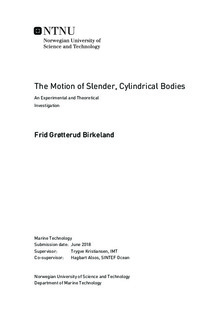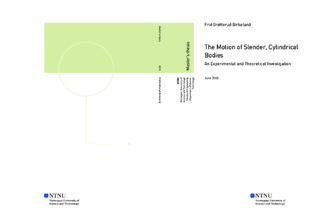| dc.contributor.advisor | Kristiansen, Trygve | |
| dc.contributor.advisor | Alsos, Hagbart | |
| dc.contributor.author | Birkeland, Frid Grøtterud | |
| dc.date.accessioned | 2019-09-11T08:51:50Z | |
| dc.date.created | 2018-06-11 | |
| dc.date.issued | 2018 | |
| dc.identifier | ntnudaim:19100 | |
| dc.identifier.uri | http://hdl.handle.net/11250/2615070 | |
| dc.description.abstract | An accidentally dropped object in the sea can result in critical damage on pipelines, platform base structures and underwater installations. This has to be accounted for during offshore operations and installations. Earlier experimental investigations performed by Aanesland in 1987, have proved that slender, cylindrical bodies in particular can experience large excursions from the drop point. The objectives of this master thesis are therefore to study the motion of slender cylinders through experimental work, compare the results with a simulation script in MATLAB based on the manoeuvring equations corrected for viscous effects, and compare the results to DNV-GL's recommended practice, DNV-GL RP F107.
Experiments were performed in the tank Dokka at Center of Marine Technology at NTNU between the 19th and 23rd of February 2018 and between the 4th and 6th of April 2018. Drops under and above the surface have been performed with capped and open, slender cylinders and cylinders where the centre of gravity has been moved 3% and 7% of the full cylinder length from the centre of volume. Drop angles were between 15 degrees and 75 degrees. In the experiments it was observed that the motions of symmetric cylinders can be described by a falling leaf-like, oscillatory motion where the excursions and the trajectories are dependent on the drop angle and slenderness of the body. For cylinders that are asymmetric about the centre of gravity, the motions can be described by a straight path or a flip followed by a straight path. These are dependent on the relative position of the centre of gravity.
The largest excursions were observed for cylinders where the relative position of the centre of gravity is 3% of the cylinder length in front of the centre of volume. With excursions of 4.65 m for a depth of 4 m, this greatly exceeds the excursion estimated based on the relevant method presented in DNV-GL RP F107. The method is general and largely underestimates the excursion for most cylinder types for small water depths. The highest velocities are obtained early in the trajectory for symmetric cylinders and converge to a constant value for asymmetric cylinders. The highest velocities occur for cylinders where the relative position of the centre of gravity is 3% of the length from the centre of volume. The maximum velocity is 3.47 m/s.
The motion of slender cylinders can be described theoretically by the manoeuvring equations corrected for viscous effects. The values of the effective trailing edge that give results most similar to the experimental results are 0.4 for small drop angles and 0.5 for steep angles. The form drag coefficient has only a small impact on the motion. Optimal values for the cross-flow drag coefficient are mostly between 1.0 and 1.2.
Overall, the simulation program gives a good estimate of the motion of a slender cylinder and the excursion at the sea bottom. The results are most accurate for symmetric cylinders, but underestimate the excursions for open cylinders. For cylinders that are asymmetric about the centre of gravity, the program overestimates the excursions for large depths. The theory as presented by Aanesland, assumes motion limited to the XZ plane, however large spreading observed in the experiments indicate that this assumption is only valid for open cylinders. The motion for all other cylinder types must therefore be calculated in three dimensions. | en |
| dc.language | eng | |
| dc.publisher | NTNU | |
| dc.subject | Marin teknikk, Marin hydrodynamikk | en |
| dc.title | The Motion of Slender, Cylindrical Bodies - An Experimental and Theoretical Investigation | en |
| dc.type | Master thesis | en |
| dc.source.pagenumber | 162 | |
| dc.contributor.department | Norges teknisk-naturvitenskapelige universitet, Fakultet for ingeniørvitenskap,Institutt for marin teknikk | nb_NO |
| dc.date.embargoenddate | 2021-06-11 | |

